Child Welfare Involvement and Youth Homelessness: The Need for Government Action
Research has shown that child welfare involvement and homelessness are closely linked, and that involvement in child protection is associated with an increased risk of homelessness (Dworsky & Courtney, 2009; Stewart et al., 2014; Wade & Dixon, 2006; Zlotnick et al., 2012). In the first pan-Canadian study on youth homelessness, Without a Home: The National Youth Homelessness Survey (2016), 57.8% of youth reported some type of involvement with child protection services over their lifetime. Compared to national data indicating that 0.3% of the general public receive child welfare services (Statistics Canada, 2011), youth experiencing homelessness are 193 times more likely to report interactions with the child welfare system.
Importantly, research has demonstrated that Indigenous and racialized youth are over-represented in child welfare services (Blackstock et al., 2004; Statistics Canada, 2011). Without a Home also revealed that transgender, gender non-binary, and LGBTQ2S youth experiencing homelessness are more likely to report child protection services involvement than cisgender and straight homeless youth. These findings highlight that child welfare involvement is powerfully linked to homelessness for many young Canadians, and that youth facing structural and systemic disadvantage (e.g., poverty, racism, homophobia) are more likely to experience both child welfare involvement and homelessness. This means that in addition to the child welfare system, many ministries and systems have a role to play in supporting youth as they transition from care. Most importantly, these findings demonstrate the need for policy change to better support some of the most marginalized young people in Canada.
Fortunately, many provinces across Canada have recently demonstrated positive policy shifts towards ensuring housing safety and stability for youth involved in the child welfare system, both in and out of care. Further, there is a national movement towards preventing youth homelessness in Canada, including through the provision of supports for youth who are transitioning from care. In addition to the child welfare system, the youth justice, education, child and youth mental health, immigration and settlement, housing and homelessness services, and the labour market each have a role to play in supporting youth as they transition from care.
At the same time, the conversation about how to address homelessness has been evolving. We are moving away from thinking only in terms of emergency services and supports to investing in prevention and helping people rapidly exit homelessness. The recently released report, A New Direction: A Framework for Homelessness Prevention, makes the case for this shift, and articulates a definition and typology that identifies where the critical points of intervention are, and who is responsible. Reintegration supports for people transitioning from public systems was identified as a priority, with a special focus on the needs of young people who have a history of involvement in child protection.
To leverage this momentum, all orders of government in Canada must consider what policies, programs, interventions, and investments can contribute to more successful transitions from care for young people. At the provincial and community level, these programmatic and policy reforms and investments will enable child welfare systems to contribute to both the prevention of youth homelessness and better outcomes for young people involved with child welfare.

